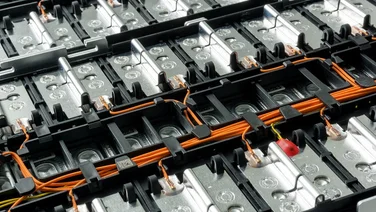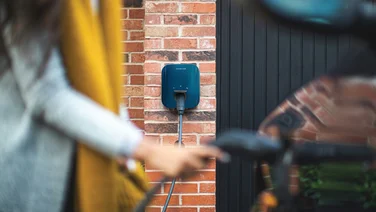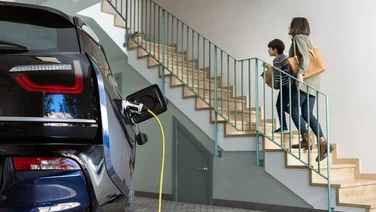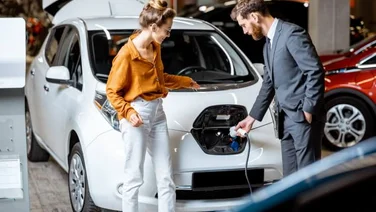- A vehicle-to-grid charger will save you £725 per year, on average
- It buys cheap electricity, and sells it back to the grid for the highest price
- The technology isn’t yet widely available, but may be soon
An electric car charging point costs around £1,000, but charging at home can save you a lot more than that overtime. Plus it doesn’t just benefit your wallet, but the climate too.
And with vehicle-to-grid (V2G) charging, you can save even more – £725 in just a year in fact.
You should shop around to get the best installation quote – and to help you with that process, we’ve created an easy-to-use comparison tool. Simply provide a few details, and we’ll pass them on to our expert installers.
Get free EV charging point quotes
Answer a few quick questions, and our trusted installers will send you bespoke EV charging point quotes – for free.

What is vehicle-to-grid charging?
Vehicle-to-grid charging allows you to charge your electric vehicle at the cheapest time, and sell any energy you don’t use back to the grid when the prices are highest.
This process enables you to use your car as a giant electric battery, as well as an investment tool – you can buy low and sell high every day, with no risk.
This means you can save money, ease the pressure on the grid, and in doing so help create a greener electricity grid.
Chargers are also being developed with vehicle-to-home (V2H) capabilities, meaning you’ll be able to choose at any given time whether to sell your excess electricity to the grid, or use it to power your home.
This could be useful if your home needs a large amount of energy during on-peak hours, or if your area suffers a blackout.
How does vehicle-to-grid charging work?
Vehicle-to-grid chargers are bidirectional, meaning they can send electricity to your vehicle – to charge it – and they can take electricity from your vehicle and send it back to the grid.
Whenever you charge an electric car, the grid’s alternating current (AC) has to be converted into direct current (DC), which your vehicle can use.
This conversion is either performed by the charger itself, or by your car.
Vehicle-to-grid chargers are able to perform the AC to DC conversion, but can also convert DC back into AC, thus pulling off the technological magic trick that makes them bidirectional, and leaves everyone thunderstruck.
Vehicle-to-grid charging also relies on smart technology, as your charger must constantly communicate with the grid to ascertain the cheapest and most expensive times to give and take electricity.
You also need smart technology to get the most out of your vehicle-to-grid charger, in the form of an app that you can use to track and change your charging habits.
By using this app, you can also ensure your car always has a minimum level of charge, in case you ever want to go on an unplanned drive.
What are the benefits of vehicle-to-grid technology?
Vehicle-to-grid technology can save you money, make the UK’s electricity greener, and expand the grid’s energy storage capacity while cutting down the amount of energy it needs to use.
This will make your electricity supply more eco-friendly, efficient, and reliable – as well as cheaper.
Save money
A three-year trial headed by OVO Energy found the company’s smart vehicle-to-grid technology saved drivers an average of £725 per year on their energy bills.
And other companies could save a huge amount of money, too – as much as £1,250 per electric fleet vehicle, according to research by Imperial College London, E.ON, and Nissan.
Widespread vehicle-to-grid charging would also allow the National Grid to buy less energy, saving £885 million over the next decade.
Cut carbon emissions
Vehicle-to-grid charging conserves energy, which is good for the planet and for the UK’s energy storage capacity.
If electric cars and vehicle-to-grid charging both become the norm, it’ll massively reduce the amount of energy we waste, as a nation.
As a result, the National Grid will have considerably more electricity to use each year, allowing it to speed up the process of moving away from fossil fuel-powered electricity to renewable sources.
Increase our electricity storage capacity
There’ll be no need to turn to coal when the price of gas increases exponentially – to use an all-too-recent example – because energy suppliers will be able to incentivise customers to sell the electricity they have in their cars back to the grid.
And we shouldn’t end up with any blackouts, because sudden spikes in energy usage can also be combated with calls for drivers to sell back their stored electricity – at a higher price, of course.
Instead of being plunged into darkness, electric car owners will end up with more money in their pockets.
How popular is vehicle-to-grid in the UK?
Vehicle-to-grid charging is only available in the UK through trial schemes, at least for the moment.
You may be able to access one of these schemes through your energy supplier, so feel free to contact them and ask.
Numerous organisations have run trials over the past few years, including energy providers British Gas, Octopus Energy, and OVO Energy, car manufacturers Nissan, and home charger producers INDRA and Wallbox.
There have even been trials carried out by companies which maintain the physical electricity networks we all rely on, like Western Power Distribution and UK Power Networks.
The only domestic vehicle-to-grid charger on the market at present is the groundbreaking Wallbox Quasar, which also comes with vehicle-to-home charging – or at least, it will when its capabilities can be fully utilised.
If you purchase a Quasar now, all you’ll be buying is an extremely expensive, completely normal home charger, with no way of using its vehicle-to-grid or vehicle-to-home abilities.
The Quasar can only be fully used if you’re on a trial scheme, as that’ll allow you to access the necessary MODBUS software (which is used to carry out the bidirectional charging) through your energy supplier.
You also need to drive one of the few cars that are currently compatible, like the Nissan LEAF or Mitsubishi Outlander PHEV.
However, more customers may be able to access this technology in the near future.
Wallbox PR manager Elyce Behrsin told The Eco Experts: “We expect Quasar to be available in more markets and to more customers very soon.”
Despite growing popularity, only 55% of people would have an EV if it were free, according to our National Home Energy Survey.
Next steps
Unfortunately, vehicle-to-grid chargers aren’t accessible to most people yet.
Wallbox and INDRA spokespeople have both expressed their hopes to us about releasing their respective chargers soon, but for now, we have to wait for this exciting future to materialise.
It also remains to be seen how much these chargers will cost when they’re mass-produced – a charger currently costs £700 to £1,000 – but they’d have to be extremely expensive to counteract their potential savings of £725 per year.
It just makes sense to weigh up different installation quotes for your perfect EV charging point. Thankfully, we’ve created an easy-to-use comparison tool to make that process straightforward.
Simply provide a few details about your home, and we’ll pass them on to our expert installers.






